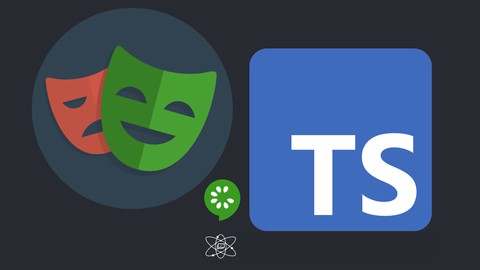
Rest API Testing (Automation) with Playwright & TypeScript
Rest API Testing (Automation) with Playwright & TypeScript, available at $19.99, has an average rating of 3.6, with 40 lectures, 6 quizzes, based on 35 reviews, and has 200 subscribers.
You will learn about How to setup your own local development environment. (IntelliJ and VSCode) Planning out our API automation suite coverage with Postman. Developing our first automation test with Playwright and JavaScript. GET, POST, PUT, PATCH and DELETE automation tests with Playwright & JavaScript. Developing our first GET cucumber scenario together. Introducing Cucumber World into our framework – Segregated test context. Passing our retrieved API response in segregated context across step definitions leveraging Cucumber World. Adding Lintrc to ensure code quality for our automation framework. Customising the cucumber-js on runtime – Dynamic Cucumber runtime arguments. Adding ENV files for better environment variables management. Introducing Global Configuration into our framework to enable dynamic host routes. Asserting on our JSON response within our automation test. Adding the Cucumber html reporter to review automation results. Adding parallel and retry capabilities to our automation framework. DELETE’ing our first post and asserting on an empty JSON response. Posting a custom json payload to our create new records. Editing posts with PATCH and asserting on our edited response. Updating posts with PUT. Asserting on unsuccessful response if we attempt to update a post that does not exist. This course is ideal for individuals who are Manual testers interested in learning Automation or Automation Engineers or Software Testers or Software Engineers or IT Professionals It is particularly useful for Manual testers interested in learning Automation or Automation Engineers or Software Testers or Software Engineers or IT Professionals.
Enroll now: Rest API Testing (Automation) with Playwright & TypeScript
Summary
Title: Rest API Testing (Automation) with Playwright & TypeScript
Price: $19.99
Average Rating: 3.6
Number of Lectures: 40
Number of Quizzes: 6
Number of Published Lectures: 40
Number of Published Quizzes: 6
Number of Curriculum Items: 46
Number of Published Curriculum Objects: 46
Original Price: A$29.99
Quality Status: approved
Status: Live
What You Will Learn
- How to setup your own local development environment. (IntelliJ and VSCode)
- Planning out our API automation suite coverage with Postman.
- Developing our first automation test with Playwright and JavaScript.
- GET, POST, PUT, PATCH and DELETE automation tests with Playwright & JavaScript.
- Developing our first GET cucumber scenario together.
- Introducing Cucumber World into our framework – Segregated test context.
- Passing our retrieved API response in segregated context across step definitions leveraging Cucumber World.
- Adding Lintrc to ensure code quality for our automation framework.
- Customising the cucumber-js on runtime – Dynamic Cucumber runtime arguments.
- Adding ENV files for better environment variables management.
- Introducing Global Configuration into our framework to enable dynamic host routes.
- Asserting on our JSON response within our automation test.
- Adding the Cucumber html reporter to review automation results.
- Adding parallel and retry capabilities to our automation framework.
- DELETE’ing our first post and asserting on an empty JSON response.
- Posting a custom json payload to our create new records.
- Editing posts with PATCH and asserting on our edited response.
- Updating posts with PUT.
- Asserting on unsuccessful response if we attempt to update a post that does not exist.
Who Should Attend
- Manual testers interested in learning Automation
- Automation Engineers
- Software Testers
- Software Engineers
- IT Professionals
Target Audiences
- Manual testers interested in learning Automation
- Automation Engineers
- Software Testers
- Software Engineers
- IT Professionals
This course has been designed to simulate a real-world experience in building both a barebones Playwright and JavaScript API Automation framework and a Cucumber, Playwright & TypeScript API automation framework from the ground up for a fully-featured API.
Upon completion, you will be able to apply your learnings and the automation framework you have built into your respective companies and projects. We are confident you will become an expert in building a world-class automation framework.
Our course and the automation framework we will build together has been developed with guidance from some of the globes leading testing and software engineering professionals and because of that we believe we can offer an incredible course where we will:
– Plan and roadmap your automation coverage with Postman.
– Develop your API automation framework against a real API.
– Build two end-to-end automation frameworks from the ground up for a full-featured end-to-end API.
– Evolve your skills and continuously improve your automation framework as we progress through the course
– Learn how to build an object-orientated – engineer-reviewed and approved automation framework.
We want this course to be the best decision you have ever made for your personal growth when it comes to improving your knowledge and skills in API test automation framework architecture.
Across many hours of exciting content, I will be at the bottom right of your screen instructing and cheering you along throughout the course. You will have everything you need to learn how to build a robust API automation framework.
Course Curriculum
Chapter 1: Introduction
Lecture 1: Introduction
Chapter 2: Setting up your development environment
Lecture 1: Getting started with node.js
Lecture 2: Setting up your development environment – Intellij
Lecture 3: Setting up your development environment – VSCODE
Lecture 4: Key Learnings
Chapter 3: API Testing with Playwright and JavaScript
Lecture 1: Planning our API automation coverage using Postman – part 1
Lecture 2: Planning our API automation coverage using Postman – part 2
Lecture 3: Planning our API automation coverage using Postman – part 3
Lecture 4: Creating our API end-to-end automation project structure and e2e folder
Lecture 5: GET, POST, PUT, PATCH and DELETE with Playwright and JavaScript – part 1
Lecture 6: GET, POST, PUT, PATCH and DELETE with Playwright and JavaScript – part 2
Lecture 7: GET, POST, PUT, PATCH and DELETE with Playwright and JavaScript – part 3
Lecture 8: GET, POST, PUT, PATCH and DELETE with Playwright and JavaScript – part 4
Lecture 9: Key Learnings
Chapter 4: Introducing Cucumber and TypeScript
Lecture 1: Running our first cucumber automation test
Lecture 2: Introducing Cucumber World – part 1
Lecture 3: Introducing Cucumber World – part 2
Lecture 4: Passing our API response to cucumber steps with Cucumber World – part 1
Lecture 5: Passing our API response to cucumber steps with Cucumber World – part 2
Lecture 6: Introducing Lintrc to ensure code quality in our automation framework
Lecture 7: Key Learnings
Chapter 5: Environment Variable Management and Custom Global Configuration
Lecture 1: Customise the cucumber-js on runtime – part 1
Lecture 2: Customise the cucumber-js on runtime – part 2
Lecture 3: Environment files for better environment variable management
Lecture 4: Introducing global configuration – Reusable getResponse function – part 1
Lecture 5: Introducing global configuration – Reusable getResponse function – part 2
Lecture 6: Key Learnings
Chapter 6: Cucumber HTML Report (Parallel and Retry)
Lecture 1: Adding more GET automation tests to our suite – part 1
Lecture 2: Adding more GET automation tests to our suite – part 2
Lecture 3: Introducing the cucumber html reporter – Adding Parallel and Retry capabilities
Lecture 4: Adding our first automation test for DELETE
Lecture 5: Key Learnings
Chapter 7: The Final 3 – Post, Patch and PUT and asserting on response text errors
Lecture 1: Creating posts with POST – part 1
Lecture 2: Creating posts with POST – part 2
Lecture 3: Editing posts with PATCH
Lecture 4: Updating posts with PUT
Lecture 5: Validating our json payload exists
Lecture 6: Asserting on response text errors
Lecture 7: Key Learnings
Chapter 8: Conclusion
Lecture 1: Concluding.. for now! More content coming soon 🙂
Instructors
-

Cameron Bradley
QA Practice Lead at Bunnings | Founder of Testing Talks
Rating Distribution
- 1 stars: 6 votes
- 2 stars: 1 votes
- 3 stars: 9 votes
- 4 stars: 2 votes
- 5 stars: 17 votes
Frequently Asked Questions
How long do I have access to the course materials?
You can view and review the lecture materials indefinitely, like an on-demand channel.
Can I take my courses with me wherever I go?
Definitely! If you have an internet connection, courses on Udemy are available on any device at any time. If you don’t have an internet connection, some instructors also let their students download course lectures. That’s up to the instructor though, so make sure you get on their good side!
You may also like
- Digital Marketing Foundation Course
- Google Shopping Ads Digital Marketing Course
- Multi Cloud Infrastructure for beginners
- Master Lead Generation: Grow Subscribers & Sales with Popups
- Complete Copywriting System : write to sell with ease
- Product Positioning Masterclass: Unlock Market Traction
- How to Promote Your Webinar and Get More Attendees?
- Digital Marketing Courses
- Create music with Artificial Intelligence in this new market
- Create CONVERTING UGC Content So Brands Will Pay You More
- Podcast: The top 8 ways to monetize by Podcasting
- TikTok Marketing Mastery: Learn to Grow & Go Viral
- Free Digital Marketing Basics Course in Hindi
- MailChimp Free Mailing Lists: MailChimp Email Marketing
- Automate Digital Marketing & Social Media with Generative AI
- Google Ads MasterClass – All Advanced Features
- Online Course Creator: Create & Sell Online Courses Today!
- Introduction to SEO – Basic Principles of SEO
- Affiliate Marketing For Beginners: Go From Novice To Pro
- Effective Website Planning Made Simple




















